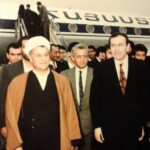In the first days of July, while the last convoys of women and children were being massacred at Dzag Kar (which means “perforated stone” in Armenian), those who bore the main responsibility for these crimes – Lieutenant Colonel Halil, the uncle of the minister of war; Cevdet Bey, the minister’s brother; Mustafa Abdülhalik, brother-in-law of the minister of the interior; and Turfan, the police chief – were at a banquet with the main butchers in an inn
located near the scene of the slaughter.
To entertain the guests and put the finishing touches on their work, the Armenian prelate and a few of the leading men of the city who had been spared until then were shot there by gendarmes that night.
The massacres organized in the vilayet of Bitlis cannot, however, be explained simply as a consequence of the activity of these high-ranking personalities, close to the highest state authorities. An entire political, administrative, military, and local governmental hierarchy was mobilized to perpetrate this violence.
The executioners in the front ranks were to be found, of course, within the leadership of the local CUP club: Muftizâde Sadullah and Gidozâde Resul, Ittihadist parliamentary deputies, and Muftizâde Nasrullah, also an Ittihadist deputy and the president of the club. Among the civilian officials who played important parts, beside Mustafa Abdülhalik, were Hamdi Effendi, the president of the municipality, and Şemeddin Fatullah, the director of the Evkaf; both were members of the commission responsible for abandoned property (emvalı metruke), and were especially heavily involved in plundering Armenian assets.
Among those in the military or related organizations, Behcet Bey, the commander-in-chief of the squadrons of the Special Organization in Bitlis, held the fairest claim to the title of chief organizer, closely followed by the Bitlis police chief Turfan Bey, who organized the arrests in the city and dispatched his men to execute the Armenians; he received help from Ahmed Refik, a police captain. Edhem Bey, the commander of the gendarmerie, and his assistant, Faik Bey, organized the convoys of deportees and provided them with their escorts; they took a direct hand in the mass slaughter.
In the Bitlis region, with its essentially Armenian and Kurdish population, tribal chieftains and local clans played a direct role in the massacres. Among them were Ilikzâde Abdurahmanoğlu Şemseddin Şamo, Yaralızâde Mehmed Salih, İbrahimzâde Haci Abdül Gani, Yusufpaşazâde Musa Effendi, Haci Melikzâde Şeyh Abdül Bek Effendi, Tüfrevizâde Şeyh Abdül Bak Effendi, Haznodarzâde Tevfi k Effendi, Kadri Şeyh Haci İbrahim, Terzi Naderzâde Haci Şemseddin, Fuadağazâde Haci Şemseddin, Karsondlizâde Haci Kasim, Karsondlizâde Haci Fato, and Molla Said.
A captain at the staff headquarters of the Ottoman army in the Caucasus who visited Bitlis in fall 1915, after its Armenian population had been wiped out, reports that there were still 300 young Armenian women in the city. Placed under guard in Bitlis’s Armenian cathedral, they served the pleasure of the officers and soldiers passing through town on their way to the front. By the time the captain visited Bitlis, most of these women had
contracted venereal diseases. The local military commander felt obliged to eradicate this scourge, which was negatively affecting the soldiers. He had the young women poisoned or otherwise put to death, with the approval of Mahmud Kâmil, the commander-in-chief of the Third Army.
To be continued
Note- this chapter is from Raymond Kévorkian’s book ARMENIAN GENOCIDE: A Complete History.
Map – http://www.houshamadyan.org/mapottomanempire/vilayet-of-bitlispaghesh.html











